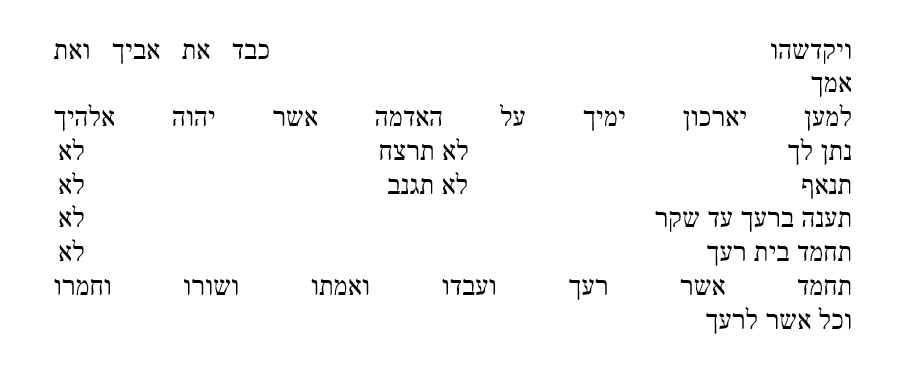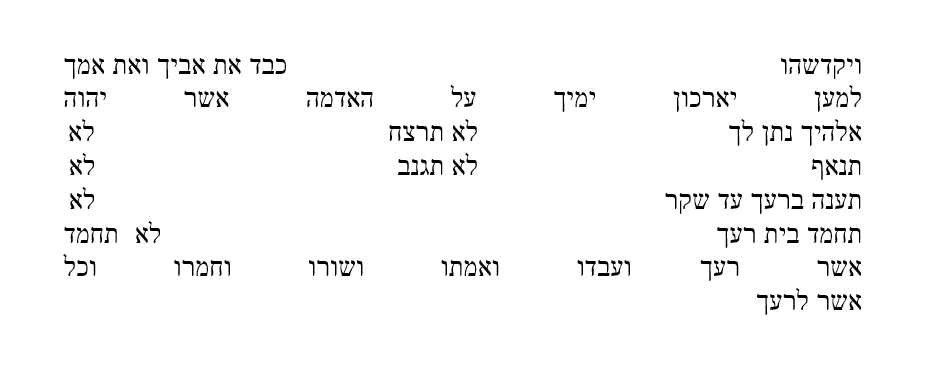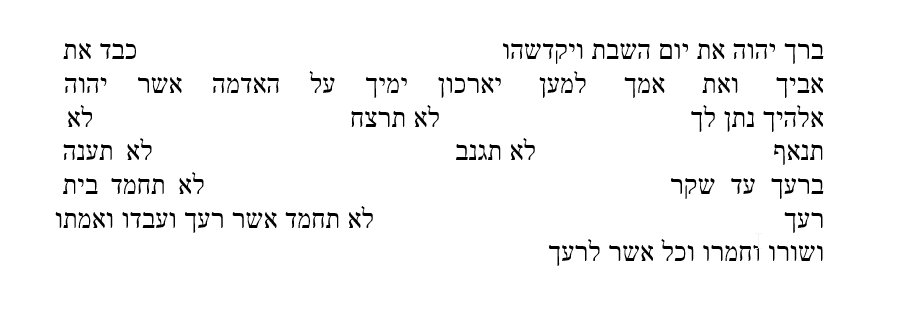It is rather typical to find the Torah's two iterations of the aseret hadibrot arranged differently from one another in a Sefer Torah. The Hebrew text displayed below indicates where, per the Masoretic Text, paragraphs are open (petucha, marked {פ}) and where they are closed (setumah, marked {ס}).
Nota bene: In some Hebrew texts of the Tanakh, e.g. Biblia Hebraica Stuttgartensia, verse 13 is numbered 13-16 and verse 14 is numbered 17. The versification for the rest of chapter 20 adjusts accordingly, synching back up at Shemot 21:1.
Text of the Sinaitic Decalogue
(א) וַיְדַבֵּ֣ר אֱלֹהִ֔ים אֵ֛ת כׇּל־הַדְּבָרִ֥ים הָאֵ֖לֶּה לֵאמֹֽר׃ {ס} (ב) אָֽנֹכִ֖י֙ יְהֹוָ֣ה אֱלֹהֶ֑֔יךָ אֲשֶׁ֧ר הוֹצֵאתִ֛יךָ מֵאֶ֥רֶץ מִצְרַ֖יִם מִבֵּ֣֥ית עֲבָדִ֑͏ֽים׃ (ג) לֹֽ֣א־יִהְיֶ֥͏ֽה־לְךָ֛֩ אֱלֹהִ֥֨ים אֲחֵרִ֖֜ים עַל־פָּנָֽ֗͏ַי׃ (ד) לֹֽ֣א־תַֽעֲשֶׂ֨ה־לְךָ֥֣ פֶ֣֙סֶל֙ ׀ וְכׇל־תְּמוּנָ֔֡ה אֲשֶׁ֤֣ר בַּשָּׁמַ֣֙יִם֙ ׀ מִמַּ֔֡עַל וַֽאֲשֶׁ֥ר֩ בָּאָ֖֨רֶץ מִתָּ֑֜͏ַחַת וַאֲשֶׁ֥ר בַּמַּ֖֣יִם ׀ מִתַּ֥֣חַת לָאָֽ֗רֶץ׃ (ה) לֹֽא־תִשְׁתַּחֲוֶ֥֣ה לָהֶ֖ם֮ וְלֹ֣א תׇעׇבְדֵ֑ם֒ כִּ֣י אָֽנֹכִ֞י יְהֹוָ֤ה אֱלֹהֶ֙יךָ֙ אֵ֣ל קַנָּ֔א פֹּ֠קֵד עֲוֺ֨ן אָבֹ֧ת עַל־בָּנִ֛ים עַל־שִׁלֵּשִׁ֥ים וְעַל־רִבֵּעִ֖ים לְשֹׂנְאָֽ֑י׃ (ו) וְעֹ֥֤שֶׂה חֶ֖֙סֶד֙ לַאֲלָפִ֑֔ים לְאֹהֲבַ֖י וּלְשֹׁמְרֵ֥י מִצְוֺתָֽי׃ {ס} (ז) לֹ֥א תִשָּׂ֛א אֶת־שֵֽׁם־יְהֹוָ֥ה אֱלֹהֶ֖יךָ לַשָּׁ֑וְא כִּ֣י לֹ֤א יְנַקֶּה֙ יְהֹוָ֔ה אֵ֛ת אֲשֶׁר־יִשָּׂ֥א אֶת־שְׁמ֖וֹ לַשָּֽׁוְא׃ {פ}
(ח) זָכ֛וֹר֩ אֶת־י֥֨וֹם הַשַּׁבָּ֖֜ת לְקַדְּשֽׁ֗וֹ׃ (ט) שֵׁ֤֣שֶׁת יָמִ֣ים֙ תַּֽעֲבֹ֔ד֮ וְעָשִׂ֖֣יתָ כׇּֿל־מְלַאכְתֶּֽךָ֒׃ (י) וְי֨וֹם֙ הַשְּׁבִיעִ֔֜י שַׁבָּ֖֣ת ׀ לַיהֹוָ֣ה אֱלֹהֶ֑֗יךָ לֹֽ֣א־תַעֲשֶׂ֣֨ה כׇל־מְלָאכָ֜֡ה אַתָּ֣ה ׀ וּבִנְךָ֣͏ֽ־וּ֠בִתֶּ֗ךָ עַבְדְּךָ֤֨ וַאֲמָֽתְךָ֜֙ וּבְהֶמְתֶּ֔֗ךָ וְגֵרְךָ֖֙ אֲשֶׁ֥֣ר בִּשְׁעָרֶֽ֔יךָ׃ (יא) כִּ֣י שֵֽׁשֶׁת־יָמִים֩ עָשָׂ֨ה יְהֹוָ֜ה אֶת־הַשָּׁמַ֣יִם וְאֶת־הָאָ֗רֶץ אֶת־הַיָּם֙ וְאֶת־כׇּל־אֲשֶׁר־בָּ֔ם וַיָּ֖נַח בַּיּ֣וֹם הַשְּׁבִיעִ֑י עַל־כֵּ֗ן בֵּרַ֧ךְ יְהֹוָ֛ה אֶת־י֥וֹם הַשַּׁבָּ֖ת וַֽיְקַדְּשֵֽׁהוּ׃ {ס} (יב) כַּבֵּ֥ד אֶת־אָבִ֖יךָ וְאֶת־אִמֶּ֑ךָ לְמַ֙עַן֙ יַאֲרִכ֣וּן יָמֶ֔יךָ עַ֚ל הָאֲדָמָ֔ה אֲשֶׁר־יְהֹוָ֥ה אֱלֹהֶ֖יךָ נֹתֵ֥ן לָֽךְ׃ {ס} (יג) לֹ֥֖א תִּֿרְצָ֖͏ֽח׃ {ס} לֹ֣֖א תִּֿנְאָ֑͏ֽף׃ {ס} לֹ֣֖א תִּֿגְנֹֽ֔ב׃ {ס} לֹֽא־תַעֲנֶ֥ה בְרֵעֲךָ֖ עֵ֥ד שָֽׁקֶר׃ {ס} (יד) לֹ֥א תַחְמֹ֖ד בֵּ֣ית רֵעֶ֑ךָ {ס} לֹֽא־תַחְמֹ֞ד אֵ֣שֶׁת רֵעֶ֗ךָ וְעַבְדּ֤וֹ וַאֲמָתוֹ֙ וְשׁוֹר֣וֹ וַחֲמֹר֔וֹ וְכֹ֖ל אֲשֶׁ֥ר לְרֵעֶֽךָ׃ {פ}
You shall not commit adultery.
You shall not steal.
You shall not bear false witness against your neighbor. (14) You shall not covet your neighbor’s house: you shall not covet your neighbor’s wife, or his male or female slave, or his ox or his ass, or anything that is your neighbor’s.
Special Formatting of the Passage
The special formatting typically begins with the word kaved (honor) at the start of Shemot 20:12. This word may, depending on the tradition, appear indented on a new line, or alternatively share a line with one or more words of the preceding verse, formatted as a typical setumah paragraph. The most common design for this passage is to arrange several of the particles of negation in a column along the left margin. The layout of the aseret hadibrot passage from Shemot 20 varies by tradition and epoch. The examples below demonstrate various methods for doing this:
- The 6-לא column design is found in Yemen in the 16th century and across North Africa in the 17th. This is also the layout exhibited in the 16th-century (?) Kaifeng (China) Torah.1

- The 4-לא column design is prominent in 18th-century Ashkenaz sifrei Torah, excluding German manuscripts. The modern Tikkun Soferim (Davidovitch) also reflects this pattern.2

- The 3-לא column design is traditional for 18th/19th-century German sifrei Torah.

- The outlier is the stairstep pattern found in some 17th-century Ottoman/Mizrahi exemplars, as below.

Notes
- David Stern, The Jewish Bible: A Material History (Seattle: University of Washington Press, 2017), 37-38.
- Menahem Davidovitch, Tikkun Soferim v'Korim (1993).





